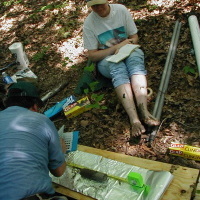Papers by Milena Mechkarska

Antibiotics
Envenomation by the Trinidad thick-tailed scorpion Tityus trinitatis may result in fatal myocardi... more Envenomation by the Trinidad thick-tailed scorpion Tityus trinitatis may result in fatal myocarditis and there is a high incidence of acute pancreatitis among survivors. Peptidomic analysis (reversed-phase HPLC followed by MALDI-TOF mass spectrometry and automated Edman degradation) of T. trinitatis venom led to the isolation and characterization of three peptides with antimicrobial activity. Their primary structures were established asTtAP-1 (FLGSLFSIGSKLLPGVFKLFSRKKQ.NH2), TtAP-2 (IFGMIPGLIGGLISAFK.NH2) and TtAP-3 (FFSLIPSLIGGLVSAIK.NH2). In addition, potassium channel and sodium channel toxins, present in the venom in high abundance, were identified by CID-MS/MS sequence analysis. TtAP-1 was the most potent against a range of clinically relevant Gram-positive and Gram-negative aerobes and against the anaerobe Clostridioides difficile (MIC = 3.1–12.5 µg/mL). At a concentration of 1× MIC, TtAP-1 produced rapid cell death (<15 min against Acinetobacter baumannii and Staphylococcu...
Journal of Peptide Science
Expert Review of Proteomics, 2019
Journal of Peptide Science, 2019
Peptides, 2017
The publisher regrets that this article has been temporarily removed. A replacement will appear a... more The publisher regrets that this article has been temporarily removed. A replacement will appear as soon as possible in which the reason for the removal of the article will be specified, or the article will be reinstated.

Virus Research, 2003
The viruses that cause hepatitis comprise of at least five different agents, which share the abil... more The viruses that cause hepatitis comprise of at least five different agents, which share the ability to cause inflammation and necrosis of the liver. The disease spectrum is quite diverse and the outcome of infection by the different hepatitis viruses can be rationalized based on virus-host cell interactions. New insights into the molecular basis of viral hepatitis reveal that three of these agents Á/ the hepatitis B, C and E viruses (HBV, HCV and HEV) modulate the mitogen-activated protein kinase (MAPK) signaling pathway. In this review we briefly describe the structural organization of the MAPK cascade and emphasize its importance as a central pathway in the signaling network. Selected mechanisms through which HBV, HCV and HEV proteins target various steps in the MAPK pathway are discussed and used to propose a pro-survival outcome for the host cell. In addition, we offer an insight into how the common theme of MAPK activation and its downstream effects may be used to rationalize the different outcomes of hepatitis B, C and E.

Metal-Based Drugs, 1998
We have found that when copper, zinc or cobalt is bound to a suitable ligand, the appropriate com... more We have found that when copper, zinc or cobalt is bound to a suitable ligand, the appropriate complex exhibited a significant anti-HSV effect (Varadinova et al., 1993; 1996). Recently published data by Sagripanti et al. (1997) also show that the inhibition of HSV by copper was enhanced by reducing agents and that mechanism of the inactivation is similar as for copper-mediated DNA damage (Aruoma, et al. 1991; Dizdaroglu, et al., 1991; Toyokuni and Sagripanti, 1994). Therefore it was interesting to study the efect of Cu(ll) coordination compounds with acyclovir (ACV) on the replication of HSV in cultured cells. The experiments on cytotoxicity as well as on the activity of three different Cu-ACV complexes [Cu(ACV)2Cl2(H2O)2] = (A); [Cu(ACV)2(H2O)3](NO3)2.H2O = (B) and [Cu(ACV)2(H2O)2](NO3)2] = (C) towards virus replication, with special attention on the growth of ACV-resistant strain R-100 were performed on MDBK cells. ACV was used as a reference compound. The following results were ob...
Journal of Clinical Virology, 2006

General and Comparative Endocrinology, 2011
Caerulein-related peptides were identified in norepinephrine-stimulated skin secretions of the te... more Caerulein-related peptides were identified in norepinephrine-stimulated skin secretions of the tetraploid frog Xenopus borealis and the octoploid frog Xenopus amieti using negative ion electrospray mass spectrometry and their primary structures determined by positive ion tandem (MS/MS) mass spectrometry. X. borealis caerulein-B1 (pGlu-Gln-Asp-Tyr(SO(3))-Gly-Thr-Gly-Trp-Met-Asp-Phe.NH2) contains an additional Gly(5) residue compared with X. laevis caerulein and caerulein-B2 (pGlu-Asp-Tyr(SO(3))-Thr-Gly-Trp-Met-Asp-Phe.NH2) contains a Gln(2) deletion. X. amieti caerulein was identical to the X. laevis peptide. In addition, xenopsin, identical to the peptide from X. laevis, together with xenopsin-AM2 (pGlu-Gly-Arg-Arg-Pro-Trp-Ile- Leu) that contains the substitution Lys(3)→Arg were isolated from X. amieti secretions. X. borealis caerulein-B1, and X. amieti xenopsin and xenopsin-AM2 produced significant (P&amp;amp;amp;amp;amp;amp;amp;amp;amp;amp;amp;amp;amp;amp;amp;amp;amp;amp;amp;amp;amp;amp;amp;amp;amp;amp;amp;amp;amp;amp;amp;amp;amp;amp;amp;amp;amp;amp;amp;amp;amp;amp;amp;amp;amp;amp;amp;amp;amp;amp;amp;amp;amp;amp;amp;amp;amp;amp;amp;amp;lt;0.05) and concentration-dependent stimulations of insulin release from the rat BRIN-BD11 clonal β cell line at concentrations ⩾30nM. The peptides did not stimulate the release of lactate dehydrogenase at concentrations up to 3μM demonstrating that the integrity of the plasma membrane had been preserved. While their precise biological role is unclear, the caerulein- and xenopsin-related peptides may constitute a component of the animal&amp;amp;amp;amp;amp;amp;amp;amp;amp;amp;amp;amp;amp;amp;amp;amp;amp;amp;amp;amp;amp;amp;amp;amp;amp;amp;amp;amp;amp;amp;amp;amp;amp;amp;amp;amp;amp;amp;amp;amp;amp;amp;amp;amp;amp;amp;amp;amp;amp;amp;amp;amp;amp;amp;amp;amp;amp;amp;amp;amp;#39;s chemical defenses against predators.

Antibiotics
Frogs from the extensive amphibian family Hylidae are a rich source of peptides with therapeutic ... more Frogs from the extensive amphibian family Hylidae are a rich source of peptides with therapeutic potential. Peptidomic analysis of norepinephrine-stimulated skin secretions from the Giant Gladiator Treefrog Boana boans (Hylidae: Hylinae) collected in Trinidad led to the isolation and structural characterization of five host-defense peptides with limited structural similarity to figainin 2 and picturin peptides from other frog species belonging to the genus Boana. In addition, the skin secretions contained high concentrations of tryptophyllin-BN (WRPFPFL) in both C-terminally α-amidated and non-amidated forms. Figainin 2BN (FLGVALKLGKVLG KALLPLASSLLHSQ) and picturin 1BN (GIFKDTLKKVVAAVLTTVADNIHPK) adopt α-helical conformations in trifluroethanol–water mixtures and in the presence of cell membrane models (sodium dodecylsulfate and dodecylphosphocholine micelles). The CD data also indicate contributions from turn structures. Both peptides and picturin 2BN (GLMDMLKKVGKVALT VAKSALLP) inh...

Comparative Biochemistry and Physiology Part D: Genomics and Proteomics, 2013
The family Pipidae comprises the genera Hymenochirus, Pipa, Pseudhymenochirus, Silurana, and Xeno... more The family Pipidae comprises the genera Hymenochirus, Pipa, Pseudhymenochirus, Silurana, and Xenopus but phylogenetic relationships within the family are unclear. Peptidomic analysis of norepinephrine-stimulated skin secretions from Pseudhymenochirus merlini Chabanaud, 1920, the single species within the genus Pseudhymenochirus, led to identification of 13 host-defense peptides with antimicrobial activity. Two peptides (hymenochirin-1Pa and-1Pb) show structural similarity to hymenochirin-1B from Hymenochirus boettgeri and eight peptides (hymenochirin-5Pa,-5Pb,-5Pc,-5Pd,-5Pe,-5Pf, 5Pg and-5Ph) are structurally similar to each other and to hymenochirin-5B from H. boettgeri. Two peptides differing by a single amino acid (IKIPSFFRNILKKVGKEAVSLM/I AGALKQS), termed pseudhymenochirin-1Pa and-1Pb, and pseudhymenochirin-2Pa (GIFPIFAKLLGKVIKVASSLISKGRTE) do not resemble host-defense peptides previously isolated from pipid frogs. Hymenochirin-5Pe was the most abundant peptide in the secretions and hymenochirin-1Pa the most potent against Staphylococcus aureus (MIC = 2.5 μM) and Escherichia coli (MIC = 10 μM). The data support a close phylogenetic relationship between Hymenochirus and Pseudhymenochirus that is distinct from the Xenopodinae (Xenopus + Silurana) clade with Pipa sister-group to all other extant pipids.

Antibiotics, 2020
Ocellatins are peptides produced in the skins of frogs belonging to the genus Leptodactylus that ... more Ocellatins are peptides produced in the skins of frogs belonging to the genus Leptodactylus that generally display weak antimicrobial activity against Gram-negative bacteria only. Peptidomic analysis of norepinephrine-stimulated skin secretions from Leptodactylus insularum Barbour 1906 and Leptodactylus nesiotus Heyer 1994, collected in the Icacos Peninsula, Trinidad, led to the purification and structural characterization of five ocellatin-related peptides from L. insularum (ocellatin-1I together with its (1–16) fragment, ocellatin-2I and its (1–16) fragment, and ocellatin-3I) and four ocellatins from L. nesiotus (ocellatin-1N, -2N, -3N, and -4N). While ocellatins-1I, -2I, and -1N showed a typically low antimicrobial potency against Gram-negative bacteria, ocellatin-3N (GIFDVLKNLAKGVITSLAS.NH2) was active against an antibiotic-resistant strain of Klebsiella pneumoniae and reference strains of Escherichia coli, K. pneumoniae, Pseudomonas aeruginosa, and Salmonella typhimurium (minim...

Journal of Biological Chemistry, 2007
The biology and pathogenesis of hepatitis E virus are poorly understood due to the lack of an in ... more The biology and pathogenesis of hepatitis E virus are poorly understood due to the lack of an in vitro culture or infection models. The viral Orf3 protein activates the cellular mitogenactivated protein kinase pathway and is likely to modulate the host cell environment for efficient viral replication. We screened for cellular genes whose transcription was differentially up-regulated in an Orf3-expressing stable cell line (ORF3/ 4). The gene for mitochondrial voltage-dependent anion channel (VDAC) was one such candidate. The up-regulation of VDAC in ORF3/4 cells was confirmed by Northern and Western blotting in various cell lines. Transfection of ORF3/4 cells with an ORF3-specific small interfering RNA led to a reduction in VDAC protein levels. VDAC is a critical mitochondrial outer membrane protein, and its overexpression results in apoptosis. Surprisingly, Orf3-expressing cells were protected against staurosporine-induced cell death by preservation of mitochondrial potential and membrane integrity. A small interfering RNA-mediated reduction in Orf3 and VDAC levels also made cells sensitive to staurosporine. Chemical cross-linking showed Orf3expressing cells to contain higher levels of oligomeric VDAC. These cells also contained higher levels of hexokinase I that directly interacted with VDAC. This interaction is known to preserve mitochondrial potential and prevent cytochrome c release. We report here the first instance of a viral protein promoting cell survival through such a mechanism.
Chemical Biology & Drug Design

Comparative biochemistry and physiology. Part D, Genomics & proteomics, Jan 30, 2018
Peptidomic analysis (reversed-phase HPLC combined with MALDI-TOF mass spectrometry and automated ... more Peptidomic analysis (reversed-phase HPLC combined with MALDI-TOF mass spectrometry and automated Edman degradation) of norepinephrine-stimulated skin secretions from the Trinidadian leaf frog Phyllomedusa trinitatis Mertens 1926 led to the identification and structural characterization of 26 host-defense peptides. On the basis of amino acid sequence similarity, the peptides may be divided into the followings groups: dermaseptins with the conserved N-terminal region GLWSKIK (6 peptides), dermaseptins with the N-terminal region ALWKXXLK (5 peptides), dermaseptins with the conserved N-terminal region GLFKTLIKGAGKMLGHVAK (4 peptides), C-terminally α-amidated and non-amidated forms of the phylloseptins (9 peptides), phyllocaerulein, a peptide (GLVSGLLNSVTGLLGNLAGGGL) with structural similarity to the plasticins, and a putative antioxidant peptide (LTWKIPTRFCGVT). The primary structures of the peptides support the claim based upon morphological criteria that P. trinitatis and Phyllomedusa...

Journal of natural products, Sep 25, 2016
Four host-defense peptides belonging to the tigerinin family (tigerinin-1O: RICTPIPFPMCY; tigerin... more Four host-defense peptides belonging to the tigerinin family (tigerinin-1O: RICTPIPFPMCY; tigerinin-2O: RTCIPIPLVMC; tigerinin-3O: RICTAIPLPMCL; and tigerinin-4O: RTCIPIPPVCF) were isolated from skin secretions of the African crowned bullfrog Hoplobatrachus occipitalis. In aqueous solution at pH 4.8, the cyclic domain of tigerinin-2O adopts a rigid amphipathic conformation that incorporates a flexible N-terminal tail. The tigerinins lacked antimicrobial (MIC > 100 μM) and hemolytic (LC50 > 500 μM) activities but, at a concentration of 20 μg/mL, significantly (P < 0.05) inhibited production of interferon-γ (IFN-γ) by peritoneal cells from C57BL/6 mice without affecting production of IL-10 and IL-17. Tigerinin-2O and -4O inhibited IFN-γ production at concentrations as low as 1 μg/mL. The tigerinins significantly (P ≤ 0.05) stimulated the rate of insulin release from BRIN-BD11 clonal β-cells without compromising the integrity of the plasma membrane. Tigerinin-1O was the most p...

Peptides, 2011
Populations of the Chiricahua leopard frog Lithobates chiricahuensis (Ranidae) occupying regions ... more Populations of the Chiricahua leopard frog Lithobates chiricahuensis (Ranidae) occupying regions in southern Arizona (southern range) are morphologically distinct from those from the Mogollon Rim of central Arizona (northern range) and a comparison of DNA sequences of mitochondrial genes has suggested that they may represent separate species. Peptidomic analysis of norepinephrine-stimulated skin secretions has led to the identification of six peptides with antimicrobial activity in samples from specimens from both groups. The primary structure of the peptides (esculentin-2 CHa, ranatuerin-2 CHa, -CHb, and -CHc, and brevinin-1 CHa and -CHb) isolated from both southern and northern range frogs are identical consistent with the proposal that the two populations are conspecific. However, palustrin-2CHa and the atypical brevinin-1 CHc (FFPTIAG*****LTKLFCA ITKKC), containing a five amino acid residue deletion, were identified only in secretions from southern range specimens. Consequently, there is some support for the proposal that the two populations are closely related but separate species but this support is relatively weak. Esculentin-2 CHa (GFSSIFRGVAKFASKGLG KDLAKLGVDLVACKISKQC) displayed the highest antimicrobial potency (MIC ≤ 10μM) against a variety of microorganisms and was only moderately hemolytic (LC(50) = 150 μM). Cladistic analysis based upon the primary structures of brevinin-1 peptides indicates a close phylogenetic relationship between L. chiricahuensis, L. onca, and L. yavapaiensis.










Uploads
Papers by Milena Mechkarska